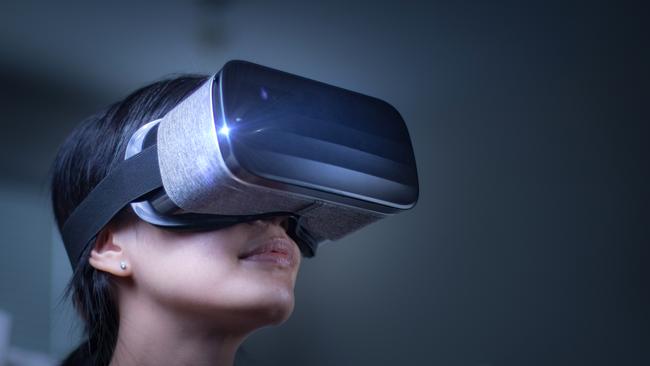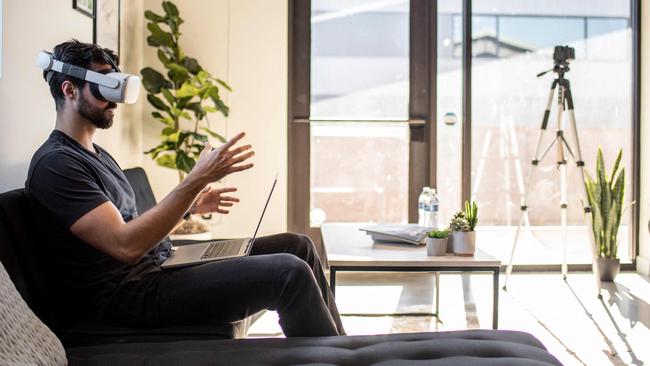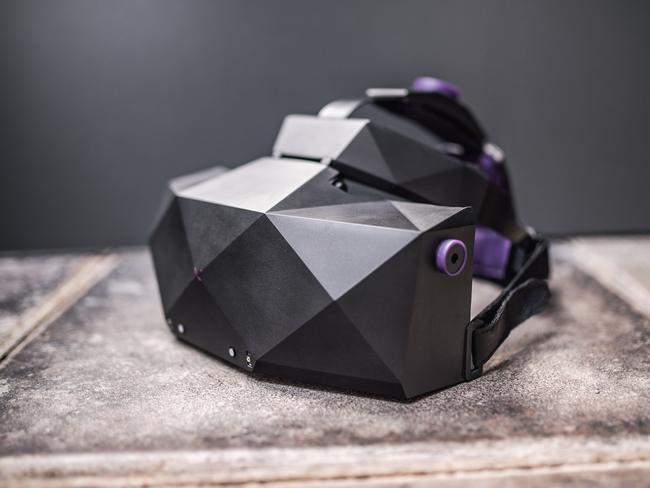VR headsets and virtual workplaces: Is this the future of work?
There’s a lot more reality that Australia will need to face – especially for its women – before we completely embrace the virtual.

Good morning and welcome to your workday. Congratulations on hitting your VR headset workout target this morning. Please log into your workplace avatar, the 3D representation of you that mirrors your movements, expressions and gestures.
Reminder: you have a client presentation in the metaverse – would you like to browse through the work looks you’ve purchased from digital boutique DressX? How about a suit from rising Swedish designer Placebo Digital Fashion House or signal your real-world love of prints with this DressX Kandinsky shirt?
Your meeting is at the client’s customised office space, with the Andrés Reisinger chairs from his recent digital furniture NFT auction. Please wait for all avatars to fill the room before you begin the fully immersive slide show in 3D. No, nobody will tell you are standing in your living room, hair wet and wearing the same activewear as yesterday.
Speculative work scenarios such as this have been hard to avoid. Meta (formerly Facebook) recently announced its ‘VR for business’, Horizon Workrooms; Microsoft, too, has a version called Mesh for Teams and open-world ‘metaverse’ platforms, such as Decentraland, Somnium Space and Sandbox have been dominating future tech talks worldwide.
In a utopian future, this is how big tech sees the evolution of work culture: virtual workplaces that are digitalised replicas of real-life offices and corporate scenarios that use VR/AR and AI to merge the physical and digital worlds. These video game-like spaces are also known as ‘the metaverse’, a broad catch-all (just like “the internet”) for digital spaces that mirror the experiences we have in the real world, particularly those involving social interactions, identity and entertainment.
The metaverse workplace, as sci-fi as it sounds, does have its appeal. Zoom has taken its toll, particularly on women who are 2.5 times more likely to experience burnout and anxiety from video conferencing than men, and many of us are still hesitant to be in-office full-time.
In addition to replicating a feeling of peer-to-peer intimacy and worker identity, the avatar-led, immersive office also introduces a new idea of equity. It removes commute time, geographical boundaries, camera pressure and the disproportionate time women spend on presentation. Plus, it creates new access points for people who might not otherwise have been able to access office spaces and certain career pathways.
However, if there’s one thing modern times have taught us, it’s that every technology that powers new opportunities will also present a new set of challenges.
“It’s a big topic among workplace futures right now, but a metaverse system doesn’t change the systems we’re existing in,” says Petah Marian, futurist and founder of Future Narrative. “And if the system’s already broken, the metaverse doesn’t provide a solution. It just creates the same problem in a virtual space.”

The immersive, virtual-reality model of work currently being talked about is an extension of the video model, which is an extension of the office experience, which still needs a rethink. The pandemic accelerated this push so fast that the evolution happened before we were able to set a destination, let alone draw up a road map.
“We haven’t figured out, or sat down and conceptualised, what the future of work should look like,” says Marian. “The disruption over the last few years has opened up our minds to the possibility of more hybrid and virtual work, but the processes aren’t there yet.”
It feels odd to be talking about technology that only a few years ago, was considered science fiction, while many workplaces still cling on to a working week schedule invented more than 200 years ago. We know that the full-time office scenario doesn’t suit modern home life, but evidence is emerging that the full time work-from home model disproportionately affects the female workforce, of all ages as well.
Trying to replicate the office environment through video conferencing hasn’t just increased our fatigue, brain fog and anxiety, but decreased our productivity, confidence and output, where the opposite has been true for men.
“We can already see what is happening, and that is women are more likely to pull themselves out of paid work,” says Alison Pennington, senior economist with The Australia Institute.
Unsurprising, when we consider the cost of childcare, normalisation of unsupportive family-friendly work arrangements and a tax system that leaves secondary earners at a disadvantage. Plus, women are more likely to be in insecure employment.
“Remote and hybrid work has been popular, but unless we can improve the system of parental leave and family flexible workplace arrangements, working from home isn’t going to be liberating for women.”
One new working model showing promise is asynchronous working. This is where workers are given full trust to execute their tasks in alignment with their personal timetables, communication is open but not immediate and productivity is not structured around set times, but the needs of workers.

The asynchronous model can be a more efficient way of working, as it removes bottlenecks caused by time-limited frameworks and gives workers the flexibility they need to meet their needs. An asynchronous model, for example, might see someone work from 7am to 12pm, then pick up their work again from 5pm to 8pm. They might work on weekends instead of weekdays and they might slot in meetings when they can.
The structure of our workday is not the only thing showing to be outdated. Australia is also facing a rethink when it comes to our aspirations and societal archetypes; the ideal worker, the ideal partner/parent and the ideal lifestyle – an almost unattainable triad of expectations.
“Sociologists have long talked about the ideal worker norms,” explains Associate Professor Leah Ruppanner, a sociologist and founding director of The Future of Work Lab at the University of Melbourne.
“The ideal worker is 100 per cent committed to their work, available 24/7, unencumbered and completely devoted to their workplace. Companies want this ideal worker, they promote them and that person will move up the ranks.”
But this norm is a direct contrast to the idea that in order to be a good parent or partner, we must be completely devoted to them.
“That tension is unsustainable. Men suffer because of it, because they want to be more engaged and present as fathers. And then women suffer because of the same reason, or because someone has to take the fall.”
Ruppanner adds, “The ideal worker norm doesn’t work for people with caregiving responsibilities and it isn’t working for young people either who ask, ‘You want me to give my whole life to this organisation and I can’t have needs outside of you?’”
“Young people’s experience of the labour market is at Depression-level. The collapse of genuine employment opportunities and the capacity to get a foot in the door is going to scar them for a lifetime.”
Introduce the pressure of self-care, a social life and the performative elements of social media, and one of these pillars of perfection is going to crack. In Australia, the great resignation is gendered. Last year, around 200,000 women left employment between May and October 2021, 68 per cent of all jobs lost during the Delta lockdowns, and nearly all were part-time.
As more women start to question their place within the workforce and lean more towards insecure work, our governments, businesses and educational institutions will need to start asking, how can we help them return?
“Australian women are some of the most highly educated in the world. Yet, in our research, when we ask women if they feel they have the right skills for future work, they say no,” says Ruppanner.
“Both things can’t be true, so there is a confidence gap. They don’t feel empowered.”
We have all seen the social media ads spruiking business courses that target women, from celebrity leadership lessons on MasterClass to what seems like every former-TED speaker’s motivational e-course – these platforms don’t necessarily teach new skills or bring subscribers into the future, with say new technology or resource training, but rather work to enforce the skills they already possess, and often at an expensive cost.
“That boom is directly responding to what is a confidence gap, not an actual skill gap. So we have work to do when it comes to building confidence around women as leaders and helping them recognise their abilities.”
At the bottom of the pile, but the most hopeful for change as we look towards the future that includes policy and participation, are Millennials and Gen Z, the most educated generations in history, who are now having to create new dreams to meet their current realities.
Youth unemployment is more than double the adult average and during a time of low confidence, employers are not investing in entry-level workers nor the training of young people that will help future-proof industries with an ageing workforce.

“We’re going to reach a point where everyone’s scratching their heads and wondering why a quarter of the workforce just turned 70 and is about to retire, wondering who’s going to fill those important skill gaps. Maybe we shouldn’t have treated a generation of young people like trash, and stopped them from being able to contribute,” says Pennington.
The myths around the ‘lazy youth’ have long been busted – you only have to open TikTok or Instagram and see how young people are using their education and entrepreneurial skills towards a variety of ventures.
“This self employment, gig work that exploits young people, is a symptom of profound disempowerment. It’s not a push to expand their agency. It’s a product of survival. That’s what gig work is,” says Pennington.
“Young people’s experience of the labour market is at Depression-level. The collapse of genuine employment opportunities and the capacity to get a foot in the door is going to scar them for a lifetime.”
Is there hope? “We need direct hiring and entry-level investment. The government has the power to create tens of thousands of direct jobs if it so wishes, and it could target those jobs at the populations most affected by the pandemic – women, young people and migrant workers.”
Australia will not be immune from further mass walkouts like we’ve seen abroad if all barometers are right. New year new you, so to speak. This is when the ripples happen.
“What’s happening now is we’re all having Covid clarity. People are thinking about their work-life alignment,” says Ruppanner. “It needs to look different in its composition. If workplaces come in with one blunt tool, they’re going to fail. Workers don’t want a simple solution; they’re gonna want something that’s tailored to their needs.”
From how we use technology to connect to how we use it to create equality, we know that the companies that introduce divergent, empathic ways of working will benefit the most.
“One of the things we’ve been talking about when we speak to corporate America and Australia is that the work-life balance is a myth,” says Ruppanner. “Because sometimes your work life is intense. And sometimes your personal life is intense. This idea that you’re supposed to balance it out is impossible.”
For some, that could mean integration of work and life, or for others, it could mean strict boundaries.
“The point is, people need specific solutions and support, without one-size-fits-all answers. Equity is an ongoing conversation that is constantly changing. Where we are seeing those company’s shareholders voting with their dollar on the future of the company, we are also seeing workers voting with their feet.”
This article appears in the February issue of Vogue Australia, on sale now.

To join the conversation, please log in. Don't have an account? Register
Join the conversation, you are commenting as Logout